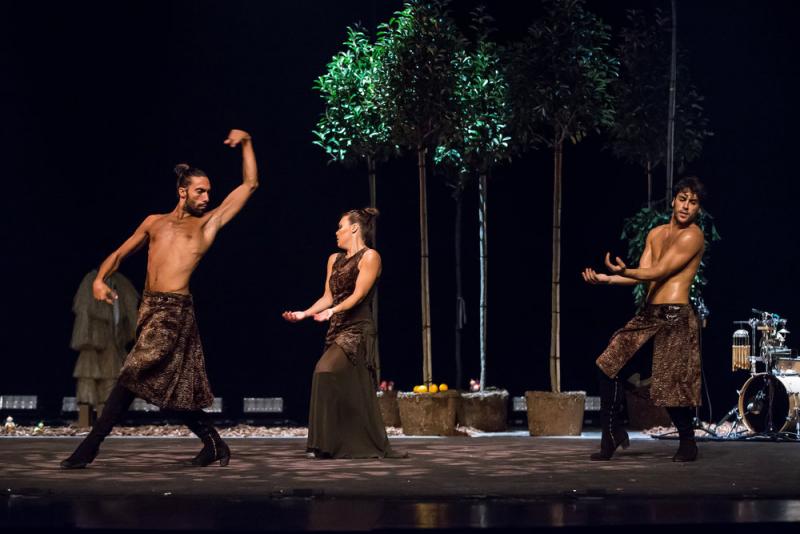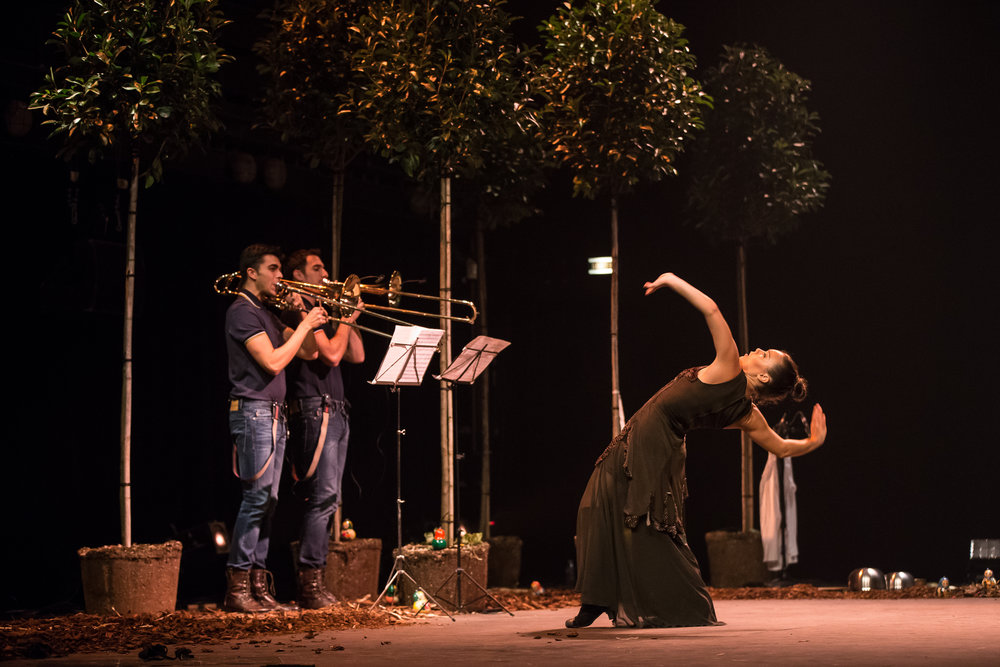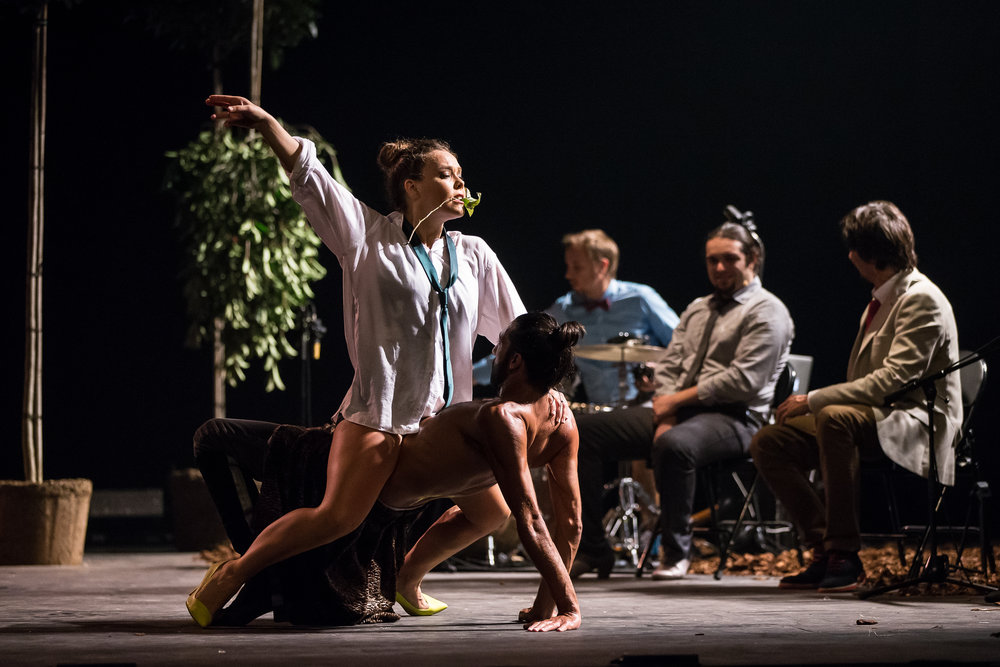Bosque Ardora, Rocío Molina, Barbican | reviews, news & interviews
Bosque Ardora, Rocío Molina, Barbican
Bosque Ardora, Rocío Molina, Barbican
Flamenco innovator presents a woodland realm to remember

Thirty-year-old Rocío Molina has been rattling cages in the hide-bound world of flamenco. Back home in Spain, gloom-mongers are predicting she’ll bring down the art form with her brazen, off-the-leash excursions from its honoured tropes. Her shows are popular.
Not one of the scenic or sartorial elements we’ve learnt to expect in theatre-mounted flamenco remains. No blood-red moon, no processional, no old men banging staves, no shawls, frills or mantillas. Molina even ditches the usual closing bulerias guaranteed to send audiences out on a partying high.
Instead, with the help of a dramaturg and video and audio artists, she has created on stage a rustling, shadowy forest (her “Bosque Ardora”), in which to play out dreams and dark yearnings, drawing on Greek myth. A film sequence sets the bosky scene, a soundscape of pops and slurps suggesting the busy fecundity of nature. Molina on horseback – as the huntress Artemis -.crashes through the trees and into a lake. Yet what emerges, sodden, is her prey, the one that always gets away: the legendary Teumessian Fox.
 For the next half-hour or more, Molina will switch back and forth between the Artemis persona (strong, fearless, indomitable) and the foxy one (sly, clever, secretive). But though it takes a while before you twig the rules of this shapeshifting game, there is much to enjoy in the live music. Clearly, Rocio Molina is not throwing out the baby with the bathwater. The cante jondo in this show, from a radiant-voiced Jose Angel Carmona, and the guitar-playing of Eduardo Trassierra, is deeply traditional, and magnificent.
For the next half-hour or more, Molina will switch back and forth between the Artemis persona (strong, fearless, indomitable) and the foxy one (sly, clever, secretive). But though it takes a while before you twig the rules of this shapeshifting game, there is much to enjoy in the live music. Clearly, Rocio Molina is not throwing out the baby with the bathwater. The cante jondo in this show, from a radiant-voiced Jose Angel Carmona, and the guitar-playing of Eduardo Trassierra, is deeply traditional, and magnificent.
But what’s this? A pair of trombonists (pictured above right)! At first I mistake them in the gloom for dancers with big shiny props. But when they launch into a fast, contrapuntal duet worthy of Hindemith, from memory, while striding about the ‘forest’, you open your ears. This is serious, virtuoso stuff, skilfully embedded in the drama. Joined by electric bass guitar, it’s wackier and more wonderful still.
Back to the inner animal: Molina initially wears a fox mask, but it’s soon discarded. She relies on subtler ways of embodying her inner vixen: her arms and hands, moulded by the tendril-furlings of flamenco, repeatedly come to rest as paws. Spins and stamps remain her default moves, but she peppers them with rhythmic twitchings, whole-body shake-outs, conversational gestures repeated on a loop, and a wilful inversion of the usual flamenco foot which involves her rocking back on her heels, digging at the floor.
 The male dancers in her team are a technical match for her. Dressed in casual clothes (one of them, in shorts, looks as if he’s been out jogging), or stripped to the waist, Eduardo Guerrero and Fernando Jimenez share much of her dance material making a tight and often thrilling unison. In her Artemis persona (dressed in nothing but teetering stilettos and a boyfriend shirt), Molina constantly gets the better of the guys, stepping over their bodies, or slapping out rhythms on a bare manly chest, just for the hell of it. There is comedy, too, as she and whichever male she happens to favour act out the awkward mating rituals of insects, or of birds, passing twigs from beak to beak. But the tone is always sharp, never romantic.
The male dancers in her team are a technical match for her. Dressed in casual clothes (one of them, in shorts, looks as if he’s been out jogging), or stripped to the waist, Eduardo Guerrero and Fernando Jimenez share much of her dance material making a tight and often thrilling unison. In her Artemis persona (dressed in nothing but teetering stilettos and a boyfriend shirt), Molina constantly gets the better of the guys, stepping over their bodies, or slapping out rhythms on a bare manly chest, just for the hell of it. There is comedy, too, as she and whichever male she happens to favour act out the awkward mating rituals of insects, or of birds, passing twigs from beak to beak. But the tone is always sharp, never romantic.
A more confusing scene shows the man as the dominating force, Molina affecting a limp, almost drunken state, losing her shoes and ending up being carried off slung across the bloke’s shoulders, like a dead deer. A second viewing might have made sense of this. But perhaps Molina is trying to tell it like it is: modern single womanhood, club culture, and all that.
Mould-breaking as it is, the spectacle reverts to type in spilling its emotional guts in its penultimate number. Quixotic, complex, even chaotic, Rocio Molina roused is like a river in spate. At one point she is apparently fighting back tears – of what? … anger, frustration, the painful, never-ending compulsion to keep up with her runaway-train feet? On this evidence, she is already a challenger for the crown, matching the soulful intensity of Eva Yerbabuena, the streamlined attack of Sara Baras. And she adds an unpredictability that is distinctly her own.
- Bosque Ardora is at the Barbican Theatre until 18 October. The Dance Umbrella Festival runs till 31 October.
The future of Arts Journalism
You can stop theartsdesk.com closing!
We urgently need financing to survive. Our fundraising drive has thus far raised £49,000 but we need to reach £100,000 or we will be forced to close. Please contribute here: https://gofund.me/c3f6033d
And if you can forward this information to anyone who might assist, we’d be grateful.

Subscribe to theartsdesk.com
Thank you for continuing to read our work on theartsdesk.com. For unlimited access to every article in its entirety, including our archive of more than 15,000 pieces, we're asking for £5 per month or £40 per year. We feel it's a very good deal, and hope you do too.
To take a subscription now simply click here.
And if you're looking for that extra gift for a friend or family member, why not treat them to a theartsdesk.com gift subscription?
more Dance
 'We are bowled over!' Thank you for your messages of love and support
Much-appreciated words of commendation from readers and the cultural community
'We are bowled over!' Thank you for your messages of love and support
Much-appreciated words of commendation from readers and the cultural community
 R:Evolution, English National Ballet, Sadler's Wells review - a vibrant survey of ballet in four acts
ENB set the bar high with this mixed bill, but they meet its challenges thrillingly
R:Evolution, English National Ballet, Sadler's Wells review - a vibrant survey of ballet in four acts
ENB set the bar high with this mixed bill, but they meet its challenges thrillingly
 Like Water for Chocolate, Royal Ballet review - splendid dancing and sets, but there's too much plot
Christopher Wheeldon's version looks great but is too muddling to connect with fully
Like Water for Chocolate, Royal Ballet review - splendid dancing and sets, but there's too much plot
Christopher Wheeldon's version looks great but is too muddling to connect with fully
 iD-Reloaded, Cirque Éloize, Marlowe Theatre, Canterbury review - attitude, energy and invention
A riotous blend of urban dance music, hip hop and contemporary circus
iD-Reloaded, Cirque Éloize, Marlowe Theatre, Canterbury review - attitude, energy and invention
A riotous blend of urban dance music, hip hop and contemporary circus
 How to be a Dancer in 72,000 Easy Lessons, Teaċ Daṁsa review - a riveting account of a life in dance
Michael Keegan-Dolan's unique hybrid of physical theatre and comic monologue
How to be a Dancer in 72,000 Easy Lessons, Teaċ Daṁsa review - a riveting account of a life in dance
Michael Keegan-Dolan's unique hybrid of physical theatre and comic monologue
 A Single Man, Linbury Theatre review - an anatomy of melancholy, with breaks in the clouds
Ed Watson and Jonathan Goddard are extraordinary in Jonathan Watkins' dance theatre adaptation of Isherwood's novel
A Single Man, Linbury Theatre review - an anatomy of melancholy, with breaks in the clouds
Ed Watson and Jonathan Goddard are extraordinary in Jonathan Watkins' dance theatre adaptation of Isherwood's novel
 Peaky Blinders: The Redemption of Thomas Shelby, Rambert, Sadler's Wells review - exciting dancing, if you can see it
Six TV series reduced to 100 minutes' dance time doesn't quite compute
Peaky Blinders: The Redemption of Thomas Shelby, Rambert, Sadler's Wells review - exciting dancing, if you can see it
Six TV series reduced to 100 minutes' dance time doesn't quite compute
 Giselle, National Ballet of Japan review - return of a classic, refreshed and impeccably danced
First visit by Miyako Yoshida's company leaves you wanting more
Giselle, National Ballet of Japan review - return of a classic, refreshed and impeccably danced
First visit by Miyako Yoshida's company leaves you wanting more
 Quadrophenia, Sadler's Wells review - missed opportunity to give new stage life to a Who classic
The brilliant cast need a tighter score and a stronger narrative
Quadrophenia, Sadler's Wells review - missed opportunity to give new stage life to a Who classic
The brilliant cast need a tighter score and a stronger narrative
 The Midnight Bell, Sadler's Wells review - a first reprise for one of Matthew Bourne's most compelling shows to date
The after-hours lives of the sad and lonely are drawn with compassion, originality and skill
The Midnight Bell, Sadler's Wells review - a first reprise for one of Matthew Bourne's most compelling shows to date
The after-hours lives of the sad and lonely are drawn with compassion, originality and skill
 Ballet to Broadway: Wheeldon Works, Royal Ballet review - the impressive range and reach of Christopher Wheeldon's craft
The title says it: as dancemaker, as creative magnet, the man clearly works his socks off
Ballet to Broadway: Wheeldon Works, Royal Ballet review - the impressive range and reach of Christopher Wheeldon's craft
The title says it: as dancemaker, as creative magnet, the man clearly works his socks off
 The Forsythe Programme, English National Ballet review - brains, beauty and bravura
Once again the veteran choreographer and maverick William Forsythe raises ENB's game
The Forsythe Programme, English National Ballet review - brains, beauty and bravura
Once again the veteran choreographer and maverick William Forsythe raises ENB's game

Add comment